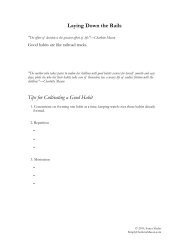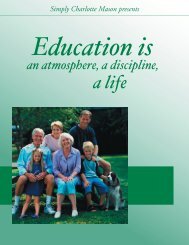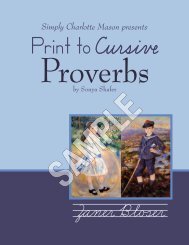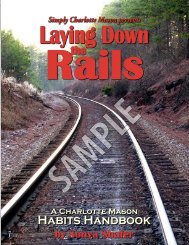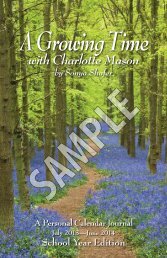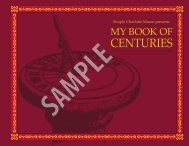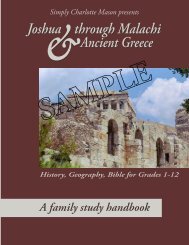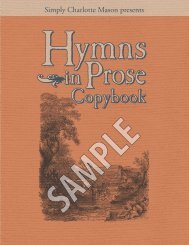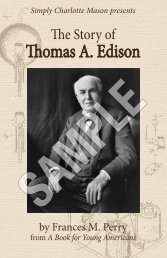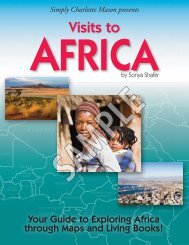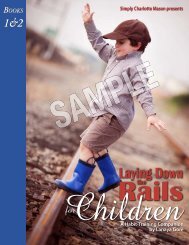Genesis through Deuteronomy & Ancient Egypt sample - Simply ...
Genesis through Deuteronomy & Ancient Egypt sample - Simply ...
Genesis through Deuteronomy & Ancient Egypt sample - Simply ...
- No tags were found...
You also want an ePaper? Increase the reach of your titles
YUMPU automatically turns print PDFs into web optimized ePapers that Google loves.
Charlotte Mason MethodsUsed in This StudyLiving BooksProbably the most well known of Charlotte Mason’s methods is her use of living books instead of dry, factualtextbooks. Living books are usually written by one person who has a passion for the subject and writes inconversational or narrative style. The books pull you into the subject and involve your emotions, so it’s easy toremember the events and facts. Living books make the subject “come alive.” The books used in this study areliving books. If you make a substitution, please do your best to select a living book.Bible Readings: The Bible is the best living book! And Charlotte encouraged us to give our children plenty ofdirect contact with the Bible itself, not feed them just watered down retellings. So you will find <strong>through</strong>out thelessons, the Scripture passages to read aloud directly from the Bible.Now, Charlotte also recommended that we should omit those portions not “suitable” for children under theage of nine (Vol. 1, p. 248; Vol. 3, p. 330). I interpret “unsuitable” to mean those instances that are graphic orsexual in nature. So I have made note of some lessons that can be skipped for the younger children. But inthose instances where the plot of the account is important for continuity in the study, I have recommendedreading the account from The Child’s Story Bible by Catherine Vos. Of all the children’s story Bibles I have seen,this is one of the best. It stays very true to Scripture and includes many details and stories that most story Biblesomit. Catherine Vos also does a wonderful job of dealing in a tactful yet truthful way with passages that couldpotentially be unsuitable for younger children.NarrationWhen you ask a child to narrate, you’re asking him to tell back in his own words what he just saw, heard,or read. The narration can be oral or written or drawn—whatever. Because the child must think <strong>through</strong> theinformation and determine how to present it, mixed with his own opinion and impressions, this method ofevaluation requires a much higher thinking level than mere fill-in-the-blank or answer-the-posed-questionwith-a-factmethods. When requesting a child to narrate, word the question in an open, essay-type form, suchas “Tell all you know about ___” or “Describe ___.”Oral Narration with Many Children: Usually it’s good to start with the youngest child, then work your way upthe ages asking if each has anything to add. However, if you use this approach every single time, the older onesmight get complacent. (“No, nothing to add.”) So you can mix things up a little by calling on any child at randomto start the narration sometimes. Not knowing who will be selected to give the oral narration keeps everybodyalert and listening. The key is to have one child start the narration and then have the others add to it, not repeatit. That mental exercise of remembering what was already mentioned and searching <strong>through</strong> your mind forsomething new to talk about is also a plus!Written Narration: Older children can be expected to take the next step and write their narrations. If your olderchild is not used to doing narration, give him several weeks or months to get used to the idea and have somepractice narrating orally first. It’s harder to keep your train of thought when you have to also think about themechanics of writing, punctuating, capitalizing, and all such trappings, so make sure your child is adept andsuccessful with organizing and expressing his thoughts orally before adding the writing aspect. Once he is an“old pro” at oral narrations, you can ease him into the written narrations by requiring just one a week or so tobegin with. The lessons in this book will give suggestions for some written narrations. You can determine whichof your students can handle those assignments.110 www.<strong>Simply</strong>CharlotteMason.com



